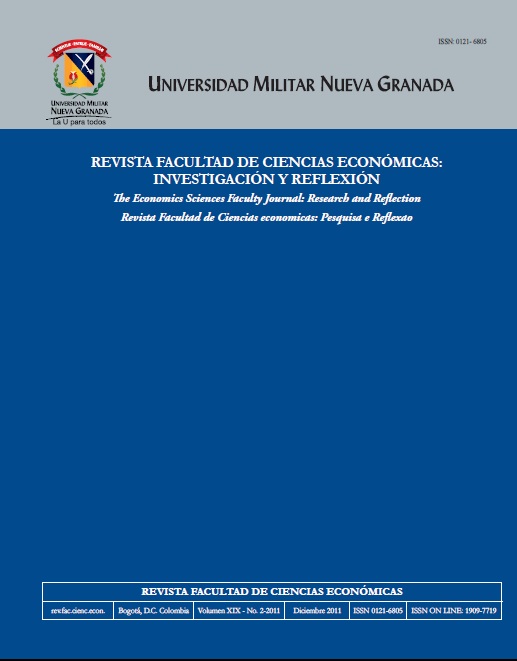Un equilibrio bayesiano de Nash: competencia a la Cournot bajo información asimétrica y productos diferenciados
Abstract
This article is a theoretical contribution in two fields of economics: game theory and industrial organization. In this article Nash-Cournot Bayesian equilibrium is calculated when two companies compete on produced quantities. One of the companies has full information on its costs and its competitor, but the other company just knows its own costs and assigns probabilities to possible costs of its competitor. Produced goods by the companies can be from completely homogeneous to completely heterogeneous. Product substitution degree determines the equilibrium effects, of both own costs and other company's costs in equilibrium quantities. The comparative static analysis of balance indicates that own costs for each company make that balance quantities decrease in a greater proportion when product substitution degree is higher. On the other hand, other company's costs increase balance quantities to the extent that products are more homogenous or replaceable.Downloads
Languages:
esReferences
Allen, F (1984). Reputation and Product Quality. En Rand Journal of Economics, 15: 311-327. http://dx.doi.org/10.2307/2555440
Bertrand, J. (1883). Théorie Mathématique de la Richesse Sociale. En Journal des Savants: 499-508.
Cournot, A. (1838). Recherches sur les Principes Mathématiques de la Théorie des Richesses. English edition (ed. N. Bacon): Researches into the Mathematical Principles of the Theory of Wealth (New York: Macmillan, 1897).
Chamberlin, E. (1933). The Theory of Monopolistic Competition. Cambridge, Mass.: Harvard University Press.
Chan, Y & H. Leland. (1982). Prices and Qualities in Markets with Costly Information. En Review of Economic Studies49: 499-516. http://dx.doi.org/10.2307/2297283
Dixit, A., & J. Stiglitz (1977). Monopolistic Competition and Optimum Product Diversity. En American Economic Review67: 297-308.
Gabszewics, J. & J.-F. Thisse, (1979). Price Competition, Quality and Income Disparities. En Journal of Economic Theory, 20: 340-359. http://dx.doi.org/10.1016/0022-0531(79)90041-3
Gibbons, R. (1992). Un primer curso de teoría de juegos. Barcelona: Antoni Bosch Editor.
Harsanyi, J. (1967). Games with Incomplete Information Played by Bayesian Players Parts I, II and III. EnManagement Science, 14:159-82,320-32,486-502.
Hirshleifer, J. (2000). Microeconomía: teoría de precios y sus aplicaciones. México: Editorial Prentice-Hall.
Hotelling, H. (1929). Stability in Competition. En Economic Journal, 39: 41-57. http://dx.doi.org/10.2307/2224214
Kihlmstrom, R., & D. Levhari. (1977). Quality, Regulation, Efficiency. En Kyklos, 30:114-234.
Lancaster, K. (1966). A New Approach to Consumer Theory. En Journal of Political Economy, 74: 132-137. http://dx.doi.org/10.1086/259131
Nash, J. (1950). Equilibrium Points in n-Person Games. En Proceedings of the National Academy of Sciences, 36: 85-98. http://dx.doi.org/10.1073/pnas.36.1.48
Salop, S. (1979). Monopolistic Competition with Outside Goods. En Bell Journal of Economics, 10: 141-156. http://dx.doi.org/10.2307/3003323
Shaked, A. & J. Sutton. (1982). Relaxing Price Competition through Product Differentiation. En Review of Economics Studies, 49: 3-13. http://dx.doi.org/10.2307/2297136
Spence, M. (1976). Product Selection, Fixed Cost and Monopolistic Competition. En Review of Economic Studies, 43: 217-235. http://dx.doi.org/10.2307/2297319
Tirole, J. (2001). The Theory of industrial Organization. Cambridge: The MIT Press.












